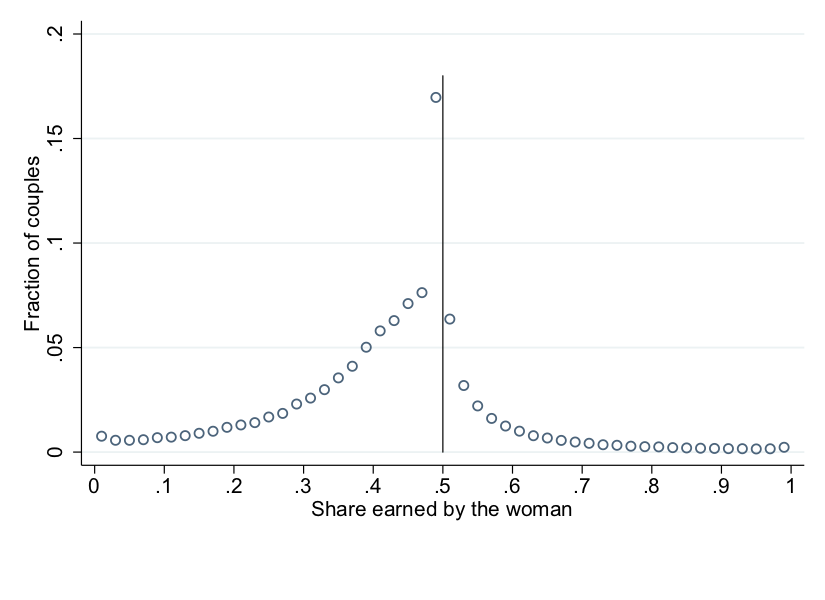
It is well known that on average women tend to earn less than their husbands. A less known fact is that there are particularly few couples in which women earn just a bit more than their husbands relatively to what one would expect — given the number of couples in which women earn just a bit less than their spouses. In other words, there is a sharp drop at 0.5 in the distribution of couples according to the proportion of household income earned by the wife (see panel a of Figure 1), a pattern that was first documented by Marianne Bertrand, Emir Kamenica and Jessica Pan in an influential article. They point out that classical economic models of household decisions cannot explain this discontinuity. Instead, they attribute the drop in the distribution to the existence of a social norm that assigns a bread-winner role to the husband. This social norm seems to be widespread.
According to the World Value Survey, 36 per cent of Americans agree with the statement “if a woman earns more money than her husband, it’s almost certain to cause problems.” In the European Union, this view is shared by 39 per cent of the population. Even in a country like Finland, 34 per cent agree with this view. Marianne Bertrand and co-authors argue that this norm may put women with high-earning potential at a disadvantage, affecting the formation of couples and inducing high-earning married women to reduce their working hours. The drop in the distribution of relative earnings would reflect that couples are particularly keen in avoiding the situation when the wife just out-earns the husband. This article has been widely cited both in the media (including the New York Times, here and here, and The Economist) and in academia.
In a recent study, we revisit the analysis by Bertrand and co-authors using exceptionally rich administrative data from Finland. We show that a similar discontinuity in the distribution of relative earnings exists among Finnish households (panel b in Figure 1). However, the Finnish data allows us to examine some additional patterns that cast doubts on the gender identity norm explanation for the existence of the discontinuity.
Figure 1. Relative earnings of women
(a) US households

Note: Includes only married couples with positive earnings. Source: SIPP Complete Gold Standard Files 1990-2004
(b) Finnish households

Source: Finnish Linked Employer-Employee Dataset (FLEED) 1988-2014. Note: Includes all cohabiting couples with positive earnings.
We observe that the discontinuity only arises within a very specific group of couples: spouses who work together (see Figure 2). This group includes around 15 per cent of working couples. Interestingly, co-working spouses, either running a small family business or working in the same large firm, are much more likely to have similar or identical earnings than spouses in other couples. In the rest of the population, there is no evidence of any unusual phenomena in the vicinity of the 0.5 point.
Figure 2. Relative earnings of women, by co-working status
(a) Different firms, not self-employed
 (b) Same firm or both self-employed
(b) Same firm or both self-employed

Source: FLEED 1988-2014. Notes: The sample includes all cohabiting couples with positive earnings.
This tendency to have similar or identical earnings does not exist at the start of cohabitation and it only emerges after couples begin co-working. As shown in Figure 3, immediately after spouses start working together, spousal earnings tend to converge, both in couples where women initially out-earned their partners and in couples where women were second earners. Given that the latter group is larger, the process of convergence moves many more households just to the left of point 0.5 than to the right of this point. At the same time, complete equalisation of earnings in a fraction of co-working couples visually “breaks” the distribution.
Figure 3. Evolution of the relative earnings of women in couples that eventually start co-working

Source: FLEED 1988-2014. Note: The sample includes all cohabiting couples that are observed in the data for at least 15 years.
The discontinuity observed in the aggregate data is thus the result of a smooth bell-shaped distribution for non-co-working couples being mixed with a distribution for co-working couples that is compressed towards the centre.
According to our findings, there is no evidence that the peculiar shape of the relative earnings distribution among co-working couples is itself an outcome of the social norm requiring the man to earn more than his wife. When spouses start co-working, their earnings tend to equalise independently of whether initially the wife earned more or less than her husband. In fact, in the majority of couples, women improve their relative earnings. Moreover, we also observe that women co-working with their spouses on average tend to have significantly higher earnings than similar women in other couples.
There may be several reasons explaining why couples running a small family business tend to equalise their earnings. If spouses are going to eventually pool their income, it would be unnecessary to negotiate different salaries. Moreover, self-employed couples may be inclined to report similar earnings to minimise the tax burden. Beside fiscal incentives, the legal environment may incentivise equal income sharing in firms with certain legal forms such as business partnerships. Earnings convergence can also arise in couples that start working in the same large firm. For instance, the existence of wage scales at the firm (or even sectoral) level may increase the likelihood that both spouses receive identical earnings. Information about each other’s earnings in some cases may also help to negotiate salaries.
In sum, the evidence suggests that the apparent lack of couples in which women just out-earn their husbands is not due to the existence of a social norm that limits the income of married women. Paradoxically, it is the result of a phenomenon, co-working couples, that helps women to have higher earnings!
We would like to emphasise that while the drop in the distribution of the relative earnings should not be considered as evidence for the existence of the gender identity norm, the norm may still play an important role for marriage decisions and for how much women work relative to men. Yet, our results indicate that, if the norm does play a role, it only gradually gains importance with the increase in the relative earnings of women, and couples do not seem to particularly mind whether the woman earns just a bit more or just a bit less than her husband.
♣♣♣
Notes:
- This blog post is based on the authors’ paper Gender Identity, Co-Working Spouses and Relative Income Within Households, presented at the Royal Economic Society 2019 conference.
- The post gives the views of its authors, not the position of LSE Business Review or the London School of Economics.
- Featured image by freestocks.org on Unsplash
- When you leave a comment, you’re agreeing to our Comment Policy.
 Natalia Zinovyeva is an assistant professor at the economics department of Aalto University in Helsinki. Her research interests are labour economics, and the economics of science and innovation.
Natalia Zinovyeva is an assistant professor at the economics department of Aalto University in Helsinki. Her research interests are labour economics, and the economics of science and innovation.
 Maryna Tverdostup is a Ph.D. student at the department of public finance of the University of Innsbruck. She does research on various topics in labour economics as well as on experimental and behavioural economics.
Maryna Tverdostup is a Ph.D. student at the department of public finance of the University of Innsbruck. She does research on various topics in labour economics as well as on experimental and behavioural economics.






2 Comments